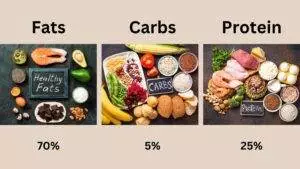
How to Stay on Track with the Ketogenic Diet: Tips and Tricks
The keto diet is a low-carb, high-fat eating plan that has gained popularity in recent years for its ability to help people lose weight quickly. But staying on track with this diet can be challenging, especially if you’re new to it. In this article, we’ll explore some tips and tricks to help you stick to your keto diet goals and achieve optimal results.
Introduction to the Ketogenic Diet
The ketogenic diet involves reducing carbohydrate intake to less than 50 grams per day while increasing fat consumption to around 70% of total calories consumed. This shift in macronutrient ratios puts the body into a state of ketosis, where it burns stored fat for energy instead of glucose from carbs. By following this diet, many people have been able to successfully shed pounds and improve their overall health.

Foods to Eat on a Keto Diet
One of the most important aspects of the keto diet is choosing the right foods to eat. Here are some examples of foods that are commonly included in a keto meal plan:
Fats: Avocado, nuts, seeds, olive oil, coconut oil, butter, cream cheese
Protein: Grass-fed beef, chicken breast, salmon, eggs, turkey bacon
Low-Carb Veggies: Spinach, broccoli, cauliflower, asparagus, mushrooms, zucchini
Common Mistakes People Make When Following a Keto Diet
While the keto diet can be incredibly effective when done correctly, there are several common mistakes that people make when trying to follow this way of eating. Some of these include:
- Consuming too much protein: While protein is an essential nutrient, consuming too much of it can kick you out of ketosis. Aim for around 1 gram of protein per pound of lean mass.
- Not tracking macros: It’s crucial to keep track of your macro nutrient intake (fats, proteins, and carbs) to ensure you’re staying within your daily limits. Use apps like MyFitnessPal or KetoDiet App to help you monitor your progress.
- Cheating too often: Cheating on your keto diet once in awhile is okay, but consistently indulging in non-keto-friendly foods can hinder your progress. Try to limit cheat meals to special occasions or once per week at most.
How to Stay in Ketosis and Avoid Cheating
Staying in ketosis is key to achieving success on the keto diet. Here are some strategies to help you avoid cheating and remain in ketosis:
Plan ahead: Meal planning is critical to successful keto dieting. Take time each week to map out your meals and snacks so you always know what you’ll be eating.
Keep healthy snacks on hand: Having keto-approved snacks available can help prevent impulse purchases of non-keto foods. Good options include hard-boiled eggs, veggie sticks with avocado dip or hummus, and unsweetened almond milk.

Get enough sleep: Lack of sleep can lead to increased cravings for sugary or processed foods. Aim for 7-8 hours of shuteye each night to help curb those cravings.
Meal Planning Tips for Successful Keto Diets
Effective meal planning is essential to maintaining a well-balanced and satisfying keto diet. Here are some tips to get started:
- Start with whole foods: Base your meals around whole, unprocessed foods such as meat, fish, vegetables, and fruits.
- Add healthy fats: Incorporate sources of healthy fats such as avocados, nuts, and oils into your meals to increase satiety and provide essential nutrients.
- Experiment with herbs and spices: Using herbs and spices can add flavor without adding extra carbs or calories.
- Consider supplementation: Certain vitamins and minerals may need to be supplemented on a keto diet due to restricted food groups. Speak with your doctor or registered dietitian about any necessary supplements.
Exercise Recommendations While on a Keto Diet
Regular exercise is recommended while on a keto diet to aid in weight loss and improve overall health. However, intense workouts can deplete glycogen stores and cause the body to rely more heavily on carbs for fuel. To balance these factors, here are some exercise recommendations for keto dieters:
- Engage in moderate-intensity cardio: Activities such as brisk walking, cycling, or swimming can help boost metabolism and promote weight loss without depleting glycogen stores.

- Include resistance training: Strength training can help build muscle mass and increase resting metabolic rate, which can further aid in weight loss.
- Listen to your body: Pay attention to how your body feels during and after exercise. If you feel sluggish or experience decreased performance, consider scaling back intensity or duration until your body adjusts to the changes.
Conclusion
The keto diet can be a highly effective tool for weight loss and improved health, but staying on track requires dedication and effort. By incorporating these tips and tricks into your routine, you can set yourself up for success and achieve your desired results.

